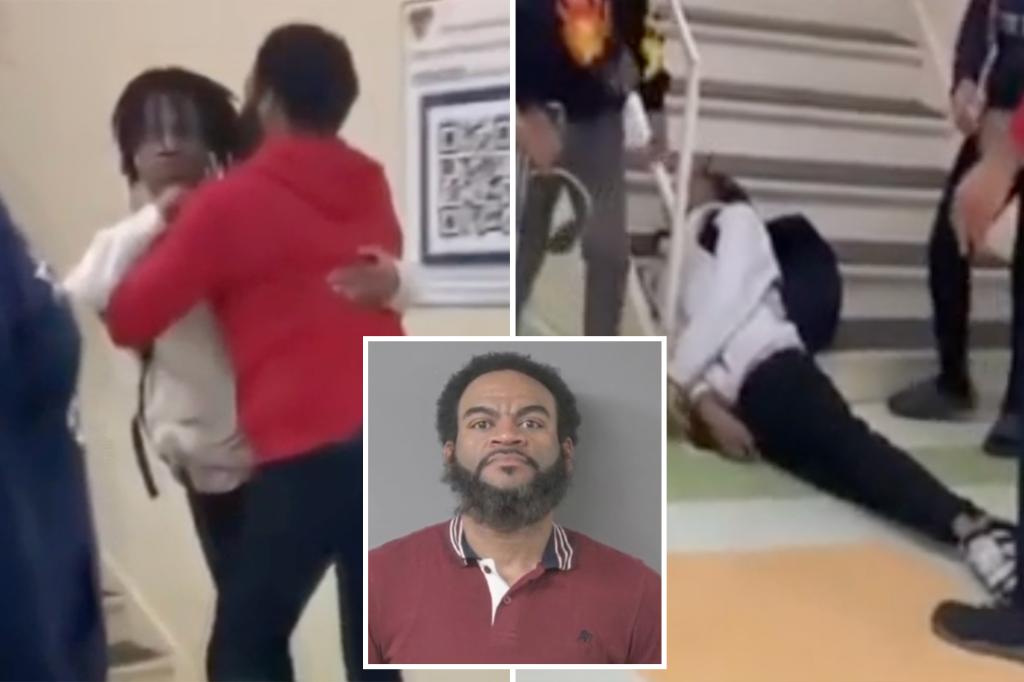Paragraph 1: Incident Overview
On a seemingly ordinary Monday morning, the tranquility of Fike High School in Wilson, North Carolina, was shattered by a violent incident. Quinton Lofton, a 43-year-old parent of a student at the school, allegedly stormed into the building and physically assaulted a 17-year-old student. The attack, captured on disturbing video footage, involved Lofton grabbing the student by the neck and throwing him onto a staircase. This act of aggression sent shockwaves through the school community, raising concerns about student safety and the circumstances that led to such a brazen act of violence within the school’s walls.
Paragraph 2: The Precipitating Conflict
The altercation stemmed from a prior dispute that occurred outside of school grounds. While the exact nature of the earlier disagreement remains undisclosed, both the school principal and the Wilson County Sheriff confirmed that the assault was a direct escalation of this external conflict. Lofton, seemingly driven by unresolved anger or a desire for retribution, entered the school with the intention of confronting the student. This premeditation raises serious questions about the security measures in place at Fike High School and whether more could have been done to prevent Lofton from gaining access to the student.
Paragraph 3: The Assault and Its Aftermath
The graphic video footage of the assault reveals the brutal nature of the attack. Lofton can be seen forcefully grabbing the student by the neck, lifting him off the ground, and throwing him down onto the stairs. The impact left the student visibly shaken and struggling to regain his composure. Fortunately, school staff intervened quickly, separating Lofton from the student and escorting him off the premises. The student, though physically shaken up and traumatized, was able to walk away from the immediate scene. This swift intervention by staff likely prevented further injury and highlights the importance of their preparedness in managing such critical situations.
Paragraph 4: Family Concerns and School Response
The student’s family expressed understandable outrage and concern over the incident. They questioned how Lofton was able to gain access to the school and carry out the assault without being immediately intercepted by security or staff. The student’s sister described him as "traumatized" by the ordeal, highlighting the emotional and psychological impact of such violence. The school administration responded to the incident by immediately contacting law enforcement. This led to the arrest of Quinton Lofton, who was subsequently charged with felony assault by strangulation and disorderly conduct. The school also took the step of banning Lofton from the premises, ensuring the student’s safety and preventing any further confrontation.
Paragraph 5: Legal Ramifications and Community Impact
Lofton’s arrest and the subsequent charges underscore the seriousness of his actions. Felony assault by strangulation carries significant penalties, highlighting the severity of the physical harm caused to the student. The disorderly conduct charge further reflects the disruption and potential danger his actions posed to the school environment. This incident inevitably impacts the entire Fike High School community. It raises crucial questions about school safety protocols and procedures, prompting a potential review of security measures to prevent similar incidents in the future.
Paragraph 6: Reflections and Moving Forward
The assault at Fike High School serves as a stark reminder of the challenges schools face in maintaining a safe and secure learning environment. The incident underscores the need for effective communication between school staff, parents, and students, as well as the importance of proactive measures to address potential conflicts before they escalate into violence. Moving forward, the school and the wider community will need to work together to rebuild trust and ensure the well-being of all students. This includes providing appropriate support and counseling services to the victim and addressing any underlying issues that may have contributed to the incident, promoting a culture of respect and non-violence within the school and community.

